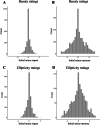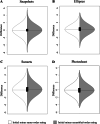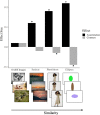The intrinsic variance of beauty judgment
- PMID: 36918510
- PMCID: PMC10167148
- DOI: 10.3758/s13414-023-02672-x
The intrinsic variance of beauty judgment
Abstract
Recall memory and sequential dependence threaten the independence of successive beauty ratings. Such independence is usually assumed when using repeated measures to estimate the intrinsic variance of a rating. We call "intrinsic" the variance of all possible responses that the participant could give on a trial. Variance arises within and across participants. In attributing the measured variance to sources, the first step is to assess how much is intrinsic. In seven experiments, we measure how much of the variability across beauty ratings can be attributed to recall memory and sequential dependence. With a set size of one, memory is a problem and contributes half the measured variance. However, we showed that for both beauty and ellipticity, with set size of nine or more, recall memory causes a mere 10% increase in the variance of repeated ratings. Moreover, we showed that as long as the stimuli are diverse (i.e., represent different object categories), sequential dependence does not affect the variance of beauty ratings. Lastly, the variance of beauty ratings increases in proportion to the 0.15 power of stimulus set size. We show that the beauty rating of a stimulus in a diverse set is affected by the stimulus set size and not the value of other stimuli. Overall, we conclude that the variance of repeated ratings is a good way to estimate the intrinsic variance of a beauty rating of a stimulus in a diverse set.
Keywords: Aesthetics; Intrinsic variability; Recall memory; Repeated measures; Sequential dependence; Subjective beauty judgments.
© 2023. The Author(s).
Figures







References
-
- Alais D, Burr D. Cue Combination Within a Bayesian Framework. In: Lee AKC, Wallace MT, Coffin AB, Popper AN, Fay RR, editors. Multisensory processes: The auditory perspective. Springer International Publishing; 2019. pp. 9–31.
-
- Albers J. Interaction of color. Yale University Press; 1971.
-
- Aue WR, Criss AH, Novak MD. Evaluating mechanisms of proactive facilitation in cued recall. Journal of Memory and Language. 2017;94:103–118. doi: 10.1016/j.jml.2016.10.004. - DOI
-
- Axelsson Ö. Individual differences in preferences to photographs. Psychology of Aesthetics, Creativity, and the Arts. 2007;1(2):61. doi: 10.1037/1931-3896.1.2.61. - DOI
MeSH terms
LinkOut - more resources
Full Text Sources
Miscellaneous

